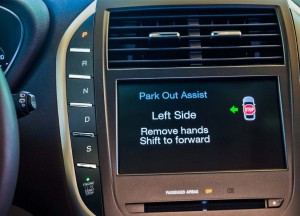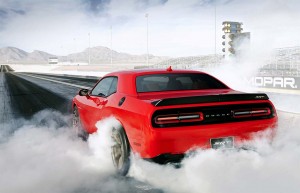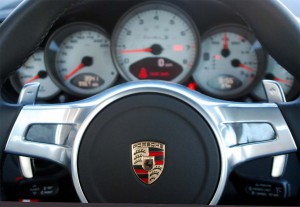Button, button, who’s got the button?
Slip inside Lincoln’s new MKC and you may be in for a surprise when you fire it up and reach to put the 2015 crossover into gear. That’s because the traditional shift lever is gone, replaced by a set of buttons on the instrument panel.
The new Chrysler 200 sedan, as well as the maker’s big Ram 1500 pickup, adopts a rotary dial to shift gears. Jaguar uses a similar system on its XF sedan, though here the knob rises out of the center console when the driver presses the start button while an indicator light pulses like a heartbeat.
A growing number of new models, from the new Mini Hardtop to the Porsche Panamera Turbo, have adopted paddle shifters akin to what you’ll find in a Formula One race car, meanwhile. Mercedes-Benz and BMW, meanwhile, have downsized the steering wheel-mounted shift levers, while Maserati and Alfa Romeo’s center console shifters are little bigger than the joysticks you’ll find on videogame controllers.
These changes are just the most visible part of a revolution in automotive design and engineering, however. Out of sight, manufacturers are also transforming the transmission itself, opting for not only more gears, but also completely new designs, such as Porsche’s PDK, an electronically shifted manual – also known as a double-clutch gearbox – that can yield significant improvements in performance even while boosting fuel economy.
Lincoln’s push-button system isn’t entirely new. Similar gearboxes were used on a number of Chrysler models in the 1960s, including the original Dodge Dart. Ford used similar technology on its failed Edsel brand, bringing the concept back, first with the latest-generation MKZ sedan, and now with the MKC compact crossover.
It’s part of Lincoln’s “less-is-more” design philosophy, explained Soo Kang, the brand’s chief interior designer.
Among other things, abandoning a conventional gearshift lever frees up space for storage bins, cupholders and armrests. Some makers are even using the newly available territory to provide a nook to hold the ever-present cellphone which otherwise might bounce around the cabin. Others have been able to adapt the space for the controllers needed for their increasingly complex infotainment systems. The redesigned 2015 Mercedes-Benz C-Class, for example, introduces an all-new touchpad interface as well as the more familiar rotary knob.
There are aesthetic, as well as functional, reasons for the movement. Automakers are under increasingly intense pressure to stand out, whether in mainstream or luxury segments. And there’s only so much they can do with leather, chrome and wood, so they’re trying to differentiate themselves with new technologies, ranging from their LCD screens down to seemingly minor details like gearshift controls.
(Automakers put a premium on “lightweighting.” Click Here to find out why.)
What makes it easy is the fact that most of the newest transmissions can be controlled electronically, eliminating the need to have a direct, mechanical link from shift lever to gearbox.
In turn, manufacturers are racing to market an assortment of new transmissions, manual, automatic and new automated manual systems, like that in the Porsche 911 that replaced the maker’s original automatic. Dubbed by the German manufacturer PDK, it’s essentially a manual without the clutch pedal. It can be operated in fully automatic mode or manually shifted using paddle shifters on the steering wheel.
Similar “manumatics” are showing up on brands as diverse as Ford and BMW, which offers the technology for its latest M3 and M4 models. It’s so effective that the PDK version of the Porsche 911 is several tenths of a second faster than the 7-speed manual model. That’s one reason double-clutch transmissions are becoming a favorite over conventional manual gearboxes, even with performance drivers.
But even automatics, usually not a preferred performance option, have vastly improved. Seven- and eight-speed automatics are common. Chrysler and Land Rover are among the growing list offering nine-speed packages, while General Motors and Ford are partnering on the development of a planned 10-speed.
(Toyota unleashing its FT-1 concept – in videogame form for Gran Turismo 6. Click Here for more.)
The benefits can include double-digit improvements in fuel economy. But using the latest in electronic controls, the automatic in the new 2015 Dodge Challenger SRT Hellcat – a 707-horsepower tire-burner – can shift in as little as 100 milliseconds, far faster than even the best professional race driver can change gears.
With all those transmission changes hidden out of sight, it’s probably no wonder automakers also are transforming the way motorists interact with their transmissions.
(Click Here to check out our tire-spinning ride in the Dodge Challenger SRT Hellcat.)




What’s old is new again. Remember the “dial to win” push button Mopars of the early ’60’s?
Push buttons while not the most convenient method are acceptable. I suspect after enough crashes we’ll see dials/knobs disappear forever – and that would be a good thing.
You want a mechanical mechanism that requires very positive user input to change gears – for safety reasons. Column and console shifters fit that requirement very well. Dials/knobs are a very bad idea as far as safety goes for changing gears.
The same applies to the reincarnation of push buttons for starting vs. using the keys in the ignition. With todays technically challenged vehicle operators using the ignition key to start/stop the vehicle should be mandatory. If that’s too much work then perhaps the operator should take the bus as they really are not qualified to operate a motorized piece of machinery?